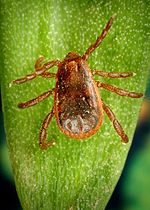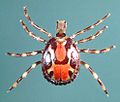Babesia, also called Nuttallia, is an apicomplexan parasite that infects red blood cells and is transmitted by ticks. Originally discovered by Romanian...
38 KB (4,356 words) - 06:58, 13 December 2024
Babesia microti is a parasitic blood-borne piroplasm transmitted by deer ticks. B. microti is responsible for the disease babesiosis, a malaria-like zoonosis...
8 KB (832 words) - 20:09, 14 December 2024
Babesiosis (category Babesia)
infection with a eukaryotic parasite in the order Piroplasmida, typically a Babesia or Theileria, in the phylum Apicomplexa. Human babesiosis transmission...
34 KB (3,401 words) - 04:14, 5 October 2024
Babesia canis is a parasite that infects red blood cells and can lead to anemia. This is a species that falls under the overarching genus Babesia. It...
7 KB (616 words) - 16:30, 15 April 2024
Babesia bovis is an Apicomplexan single-celled parasite of cattle which occasionally infects humans. The disease it and other members of the genus Babesia...
4 KB (385 words) - 16:30, 15 April 2024
Babesia caballi is a species belonging to Alveolata and the family Babesiidae. In horses, it causes the babesiosis disease, called "equine babesiosis"...
1 KB (102 words) - 23:10, 22 April 2024
Babesia divergens is an intraerythrocytic parasite, transmitted by the tick Ixodes ricinus. It is the most common cause of human babesiosis. It is the...
5 KB (516 words) - 13:15, 12 June 2024
medicine as an antiprotozoal agent for the treatment of infection with Babesia (babesiosis) and other parasites. Imidocarb is anticholinergic; it inhibits...
3 KB (165 words) - 03:40, 24 November 2024
Babesia bigemina is a species of alveolates belonging to the phylum Apicomplexa and the family Babesiidae, a type of protozoan parasite. In cattle, it...
2 KB (198 words) - 23:10, 22 April 2024
Theileria (redirect from Babesia equi)
T. equi causes equine piroplasmosis. It was originally classified as Babesia equi in 1901 by Charles Louis Alphonse Laveran, but was reclassified as...
9 KB (902 words) - 19:14, 10 December 2024
reproduction occurs in the tick gut). They include the tick parasites Babesia and Theileria. They are minute rounded or pyriform parasites found within...
4 KB (332 words) - 02:40, 3 November 2023
Babesia motasi is a species belonging to Alveolata and the family Babesiidae. In sheep causes babesiosis disease, called "sheep babesiosis". Babesia motasi...
1 KB (73 words) - 23:10, 22 April 2024
ruptures. Organisms whose life cycles rely on this process include Theileria, Babesia, Plasmodium, and Toxoplasma gondii. Sporogony is a type of sexual and asexual...
13 KB (1,357 words) - 23:33, 22 November 2023
chor (="coin thief"). A blood parasitic protozoan Trypanosoma corvi and Babesia has been reported from this species. Trematode parasites, Haplorchis vagabundi...
12 KB (1,239 words) - 09:30, 2 March 2024
haemogregarines, and plasmodia. Diseases caused by Apicomplexa include: Babesiosis (Babesia) Malaria (Plasmodium) Cryptosporidiosis (Cryptosporidium parvum) Cyclosporiasis...
46 KB (4,906 words) - 10:20, 27 November 2024
identified babesiosis with xenodiagnosis, both in hamsters for Babesia microti and in gerbils for Babesia divergens. They now use faster diagnostic measures. Xenodiagnosis...
2 KB (220 words) - 22:25, 28 April 2023
Mountain spotted fever in humans in the Southwestern United States. Babesia vogeli Babesia canis Coxiella burnetii Ehrlichia canis Hepatozoon canis Mycoplasma...
10 KB (959 words) - 22:19, 1 October 2024
and R. decoloratorus. Development of Babesia in the tick is complex and includes sexual reproduction. These Babesia are transmitted from adult female boophilid...
63 KB (7,887 words) - 06:49, 28 August 2024
only a mitosome, the circular mitochondrial genomes of Acavomonas and Babesia microti, and Toxoplasma's highly fragmented mitochondrial genome, consisting...
26 KB (2,664 words) - 03:34, 2 November 2024
Babesia sp. 'North Carolina dog' is an unclassified species of Babesia, identified from a 18S ribosomal gene partial sequence performed in the investigation...
2 KB (131 words) - 16:30, 15 April 2024
usually divided into: Unicellular organisms (e.g. malaria, Toxoplasma, Babesia) Macroparasites (worms or helminths) including nematodes such as parasitic...
117 KB (12,760 words) - 10:49, 31 December 2024
OPSI particularly dangerous. Another source of infection are species of Babesia, which are tick-borne parasites that cause babesiosis. OPSI may initially...
12 KB (1,209 words) - 07:56, 14 September 2024
Malaria. P. falciparum, P. vivax, and P. malariae are pathogenic to humans. Babesia Gymnosporangium and other rusts Pyrenophora teres Cordyceps Pentastomida...
4 KB (302 words) - 18:16, 21 July 2024
Babesiidae is a family of protists belonging to the order Piroplasmida. Genera: Babesia Starcovivi, 1893 Echinozoon Garnham, 1951 "IRMNG - Babesiidae". www.irmng...
701 bytes (30 words) - 18:21, 22 December 2024
variety of brand names. It is effective against certain protozoa such as Babesia, Trypanosoma, and Cytauxzoon. The drug may also be effective against certain...
4 KB (275 words) - 18:57, 6 May 2024
Texas fever is a disease caused by infection with Babesia. Texas fever may also refer to: Texas Fever, an album by Orange Juice Texas Fever (novel), a...
247 bytes (63 words) - 09:50, 1 November 2023
Life cycle of the apicomplexan, single-celled parasite Babesia, including infection of humans...
24 KB (2,971 words) - 22:18, 24 December 2024
of the amidine class used in veterinary medicine. It is used to treat Babesia infection (babesiosis) dogs, horses, and cattle. Because the drug causes...
2 KB (82 words) - 00:58, 5 June 2024
differentiation from another major tick-borne disease, bovine babesiosis, caused by Babesia bigemina. Species of veterinary interest include: Anaplasma marginale and...
5 KB (384 words) - 09:08, 6 December 2024
(Haemoproteus) Leucocytozoidae (Leucocytozoon) Plasmodiidae (Plasmodium) Piroplasmida Babesiidae (Babesia) Theileriidae (Theileria) Cardiosporidium Nephromyces...
70 KB (7,379 words) - 22:44, 3 December 2024




















